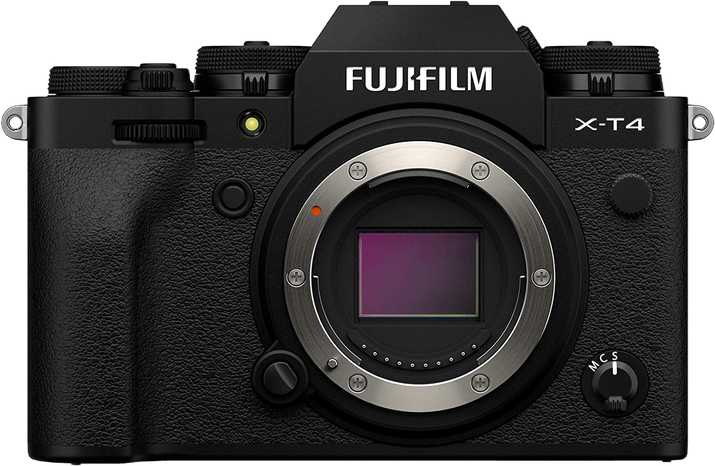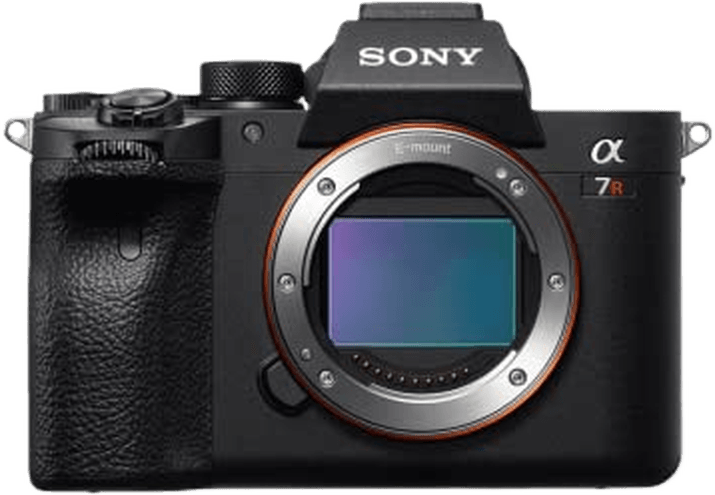Fujifilm X-T4 vs Sony a7R IV Comparison
Fujifilm X-T4

Sony a7R IV

The Sony a7R IV outperforms the Fujifilm X-T4 with a score of 84/100 compared to 76/100. Both cameras are mirrorless and were released within a year of each other, in 2019 and 2020, respectively. They share similar dimensions, with the Sony a7R IV being slightly heavier at 665g compared to the Fujifilm X-T4’s 607g.
The Sony a7R IV’s higher score indicates its superior performance, justifying its higher launch price of $3500 compared to the Fujifilm X-T4’s $1699. However, the Fujifilm X-T4 holds its own with a more lightweight design, making it easier to carry around for longer periods.
Taking all factors into account, the Sony a7R IV emerges as the better camera due to its higher score, while the Fujifilm X-T4 offers a more budget-friendly and lightweight option for those willing to compromise on performance.
Fujifilm X-T4 vs Sony a7R IV Overview and Optics
The Sony a7R IV outperforms the Fujifilm X-T4 in optics, with a score of 85/100 compared to the X-T4’s 73/100. Both cameras share some common specifications, such as CMOS sensor type, image stabilisation, and compatibility with their respective lens mounts – Fujifilm X for the X-T4 and Sony FE for the a7R IV.
The Sony a7R IV surpasses the Fujifilm X-T4 in several aspects. With a remarkable 61.2 megapixels, the a7R IV offers more than double the resolution of the X-T4’s 26 megapixels, resulting in sharper and more detailed images. Furthermore, the a7R IV features a full-frame sensor, which provides better low-light performance and a shallower depth of field. The camera’s sensor also has a DXOMARK score of 99, indicating excellent image quality.
On the other hand, the Fujifilm X-T4 has its advantages as well. Its shooting speed of 20 frames per second is faster than the a7R IV’s 10 frames per second, making it more suitable for capturing fast-moving subjects. Additionally, the X-T4 is equipped with the X-Processor 4, a powerful processor that ensures quick image processing and enhanced performance.
While the Sony a7R IV excels in image quality and sensor capabilities, the Fujifilm X-T4 offers a faster shooting speed. Ultimately, the choice between these two cameras depends on the specific needs of the photographer. If high-resolution images and low-light performance are priorities, the Sony a7R IV is the better choice. However, for those who require rapid shooting capabilities, the Fujifilm X-T4 is the more suitable option.
Fujifilm X-T4 vs Sony a7R IV Video Performance
The Fujifilm X-T4 outperforms the Sony a7R IV in video capabilities, scoring 91 out of 100 points compared to the Sony a7R IV’s score of 70. Both cameras share some common features, such as 4K max video resolution and built-in time-lapse functionality. However, the Fujifilm X-T4 has several advantages over the Sony a7R IV, making it the better choice for videographers.
The Fujifilm X-T4 has a higher maximum video dimension of 4096 x 2160, whereas the Sony a7R IV’s max video dimension is 3840 x 2160. This difference allows the X-T4 to produce higher-quality footage. Additionally, the X-T4 has a significantly higher maximum video frame rate of 120fps, compared to the Sony a7R IV’s 30fps. This enables the Fujifilm X-T4 users to capture smoother slow-motion footage and fast-moving subjects with greater ease.
The Sony a7R IV, despite having a lower video score, may still be suitable for some users. Its 4K resolution and time-lapse functionality are on par with the Fujifilm X-T4. However, the lower maximum video dimensions and frame rate make it less versatile for advanced videography needs.
When comparing the video capabilities of the Fujifilm X-T4 and the Sony a7R IV, the X-T4 is the clear winner due to its higher maximum video dimensions and frame rate. For individuals seeking a camera primarily for video purposes, the Fujifilm X-T4 would be the better choice. The Sony a7R IV, while still offering decent video features, may not be the optimal choice for those prioritizing advanced video capabilities.
Fujifilm X-T4 vs Sony a7R IV Features and Benefits
The Fujifilm X-T4 edges out the Sony a7R IV in features with a score of 85/100, compared to the Sony’s 83/100. Both cameras share several specifications, making them comparable in many aspects. They have the same screen size of 3 inches, touchscreen capabilities, flip screens, and lack of GPS. Additionally, both cameras are equipped with WIFI and Bluetooth functionality.
The Fujifilm X-T4 surpasses the Sony a7R IV in screen resolution, boasting 1,620,000 dots as opposed to Sony’s 1,440,000 dots. This higher resolution provides the X-T4 with a clearer and sharper display, which enhances the user experience when previewing images and navigating the camera’s menu.
While the Sony a7R IV has a slightly lower feature score, it remains a strong competitor. The two-point difference in scores may not be significant enough to sway the decision for some users. However, this comparison does not cover other aspects such as image quality, performance, and price, which could play a crucial role in the final decision.
Given the feature comparison, the Fujifilm X-T4 has a slight advantage over the Sony a7R IV. The higher screen resolution is the main contributing factor to its lead. However, both cameras share many similarities in features, making them strong contenders in their respective categories. Ultimately, the choice between the two depends on the user’s personal preferences and requirements outside of the features discussed.
Fujifilm X-T4 vs Sony a7R IV Storage and Battery
The Sony a7R IV outperforms the Fujifilm X-T4 in storage and battery with a score of 79/100 compared to 73/100. Both cameras have two memory card slots and accept SD, SDHC, and SDXC (UHS-II compatible) cards. They also both support USB charging.
The Sony a7R IV has a better battery life of 670 shots, while the Fujifilm X-T4 offers 500 shots. The Sony camera uses an NP-FZ100 battery, whereas the Fujifilm model uses an NP-W235 battery. This longer battery life makes the Sony a7R IV more suitable for extended shooting sessions.
The Fujifilm X-T4, however, does not surpass the Sony a7R IV in any specific aspect of storage and battery. Therefore, the Sony a7R IV is the clear winner in this category due to its longer battery life, giving users more time to capture the perfect shot.
Fujifilm X-T4 vs Sony a7R IV Alternatives
Still not ready to make a decision? Check out our other popular camera comparisons for inspiration:
 
